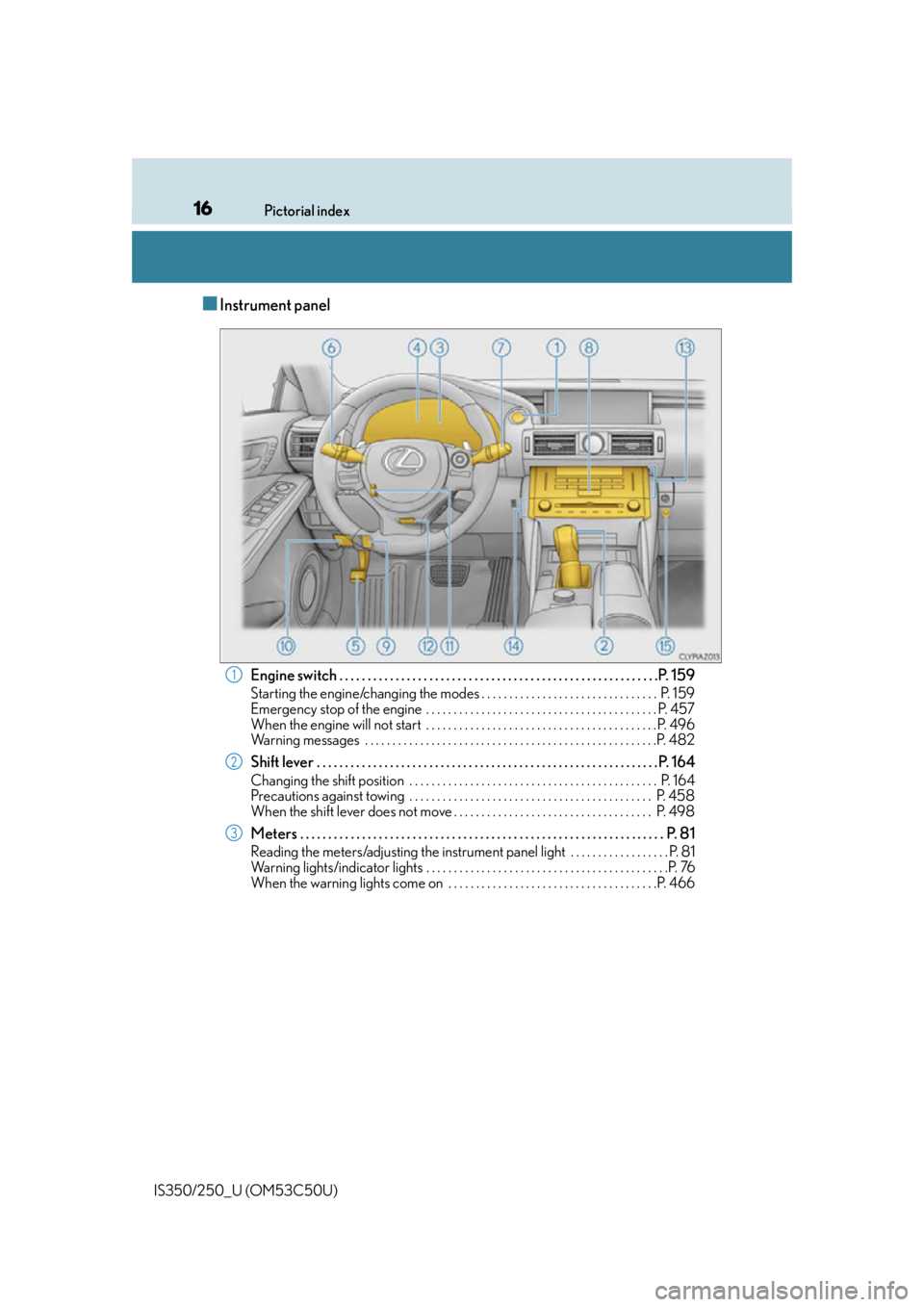tow Lexus IS250 2015 Audio menu screen operation /
[x] Cancel search | Manufacturer: LEXUS, Model Year: 2015, Model line: IS250, Model: Lexus IS250 2015Pages: 584, PDF Size: 7.59 MB
Page 3 of 584

3
1
9 8
7 5 4
3
2
10
IS350/250_U (OM53C50U)
6
4-1. Before driving Driving the vehicle ......................146
Cargo and luggage.....................153
Vehicle load limits ........................156
Trailer towing ................................. 157
Dinghy towing .............................. 158
4-2. Driving procedures Engine (ign ition) switch .............159
Automatic transmission ............164
Turn signal lever ............................ 170
Parking brake ................................ 172
4-3. Operating the lights and wipers
Headlight switch .......................... 173
Automatic High Beam............... 176
Fog light switch .............................. 181
Windshield wipers and washer .......................................... 182
4-4. Refueling Opening the fuel tank cap ...... 188 4-5. Using the driving
support systems
Cruise control ...............................192
Dynamic radar cruise control ...........................................196
LDA (Lane Departure Alert)........208
Intuitive parking assist ................ 214
Lexus parking assist monitor.......................................... 221
Driving mode select switch ............................................237
Driving assist systems .............. 240
PCS (Pre-Collision System) ..........246
BSM (Blind Spot Monitor) ............. 252
• The Blind Spot Monitor function .................................... 255
• The Rear Cross Traffic Alert function .........................257
4-6. Driving tips Winter driving tips ..................... 260
4Driving
Page 7 of 584

7
1
9 8
7 5 4
3
2
10
IS350/250_U (OM53C50U)
6
8-2. Steps to take in an emergency
If your vehicle needs to be towed ........................................... 458
If you think something is wrong........................................... 464
Fuel pump shut off system ...... 465
If a warning light turns on or a warning buzzer
sounds ......................................... 466
If a warning message is displayed ..................................... 472
If you have a flat tire .................. 486
If the engine will not start ........ 496
If the shift lever cannot be shifted from P ........................... 498
If the electronic key does not operate properly ............. 499
If the vehicle battery is discharged ................................. 502
If your vehicle overheats ......... 506
If the vehicle becomes stuck .............................................509 9-1. Specifications
Maintenance data (fuel, oil level, etc.) ....................512
Fuel information ......................... 522
Tire information........................... 525
9-2. Customization Customizable features .............537
9-3. Initialization Items to initialize......................... 546
Reporting safety defects for U.S. owners ........................ 548
Seat belt instructions for Canadian owners
(in French).................................. 549
SRS airbag instructions for Canadian owners
(in French).................................. 550
What to do if... (Troubleshooting) ............................... 560
Alphabetical index ................................ 5649Vehicle specifications
10For owners
Index
For vehicles with a navigation system, refer to the “NAVIGATION SYSTEM
OWNER’S MANUAL” for information rega rding the equipment listed below.
• Navigation system
• Audio/video system•Intuitive parking assist
•Rear view monitor system
Page 16 of 584

16Pictorial index
IS350/250_U (OM53C50U)
■Instrument panel
Engine switch . . . . . . . . . . . . . . . . . . . . . . . . . . . . . . . . . . . . . . . . . . . . . . . . . . . . . . . . . P. 1 5 9
Starting the engine/changing the modes . . . . . . . . . . . . . . . . . . . . . . . . . . . . . . . . P. 159
Emergency stop of the engine . . . . . . . . . . . . . . . . . . . . . . . . . . . . . . . . . . . . . . . . . . P. 457
When the engine will not start . . . . . . . . . . . . . . . . . . . . . . . . . . . . . . . . . . . . . . . . . . P. 496
Warning messages . . . . . . . . . . . . . . . . . . . . . . . . . . . . . . . . . . . . . . . . . . . . . . . . . . . . .P. 48 2
Shift lever . . . . . . . . . . . . . . . . . . . . . . . . . . . . . . . . . . . . . . . . . . . . . . . . . . . . . . . . . . . . . P. 164
Changing the shift position . . . . . . . . . . . . . . . . . . . . . . . . . . . . . . . . . . . . . . . . . . . . . P. 164
Precautions against towing . . . . . . . . . . . . . . . . . . . . . . . . . . . . . . . . . . . . . . . . . . . . P. 458
When the shift lever does not move . . . . . . . . . . . . . . . . . . . . . . . . . . . . . . . . . . . . P. 498
Meters . . . . . . . . . . . . . . . . . . . . . . . . . . . . . . . . . . . . . . . . . . . . . . . . . . . . . . . . . . . . . . . . . P. 81
Reading the meters/adjusting the instrument panel light . . . . . . . . . . . . . . . . . . P. 81
Warning lights/indicator lights . . . . . . . . . . . . . . . . . . . . . . . . . . . . . . . . . . . . . . . . . . . .P. 76
When the warning lights come on . . . . . . . . . . . . . . . . . . . . . . . . . . . . . . . . . . . . . .P. 466
1
2
3
Page 32 of 584

321-1. For safe use
IS350/250_U (OM53C50U)
■After the rear center seat belt has been used
■Emergency locking retractor (ELR)
The retractor will lock the belt during a sudden stop or on impact. It may also lock if you
lean forward too quickly. A slow, easy motion w ill allow the belt to extend so that you can
move around fully.
■Automatic locking retractor (ALR)
When a passenger’s shoulder belt is completely extended and then retracted even
slightly, the belt is locked in that position an d cannot be extended. This feature is used to
hold a child restraint system (CRS) firmly. To fr ee the belt again, fully retract the belt and
then pull the belt out once more. ( P. 5 8 )
■Child seat belt usage
The seat belts of your vehicle were princi pally designed for persons of adult size.
●Use a child restraint system appropriate fo r the child, until the child becomes large
enough to properly wear the vehicle’s seat belt. ( P. 5 4 )
●When the child becomes large enough to properly wear the vehicle’s seat belt, follow
the instructions regardin g seat belt usage. (P. 3 0 )
■Replacing the belt after the pretensioner has been activated
If the vehicle is involved in multiple collisio ns, the pretensioner will activate for the first
collision, but will not activate for th e second or subsequent collisions.
■Seat belt extender Stow the buckle as shown.
If your seat belts cannot be fastened securely
because they are not long enough, a personal-
ized seat belt extender is available from your
Lexus dealer free of charge.
Page 39 of 584

391-1. For safe use
1
For safety and security
IS350/250_U (OM53C50U)
CAUTION
■SRS airbag precautions
Observe the following precautions regarding the SRS airbags.
Failure to do so may cause death or serious injury.
●The driver and all passengers in the vehicle must wear their seat belts properly.
The SRS airbags are supplemental devices to be used with the seat belts.
●The SRS driver airbag deploys with consider able force, and can cause death or seri-
ous injury especially if the driver is very close to the airbag. The National Highway
Traffic Safety Administration (NHTSA) advises:
Since the risk zone for the driver’s airbag is the first 2 - 3 in. (50 - 75 mm) of inflation,
placing yourself 10 in. (250 mm) from your driver airbag provides you with a clear
margin of safety. This distance is measured from the center of the steering wheel to
your breastbone. If you sit less than 10 in. (250 mm) away now, you can change your
driving position in several ways:
• Move your seat to the rear as far as you can while still reaching the pedals com- fortably.
• Slightly recline the back of the seat. Although vehicle designs vary, many drivers can achieve the 10 in. (250 mm) dis-
tance, even with the driver seat all the wa y forward, simply by reclining the back of
the seat somewhat. If reclining the back of your seat makes it hard to see the road,
raise yourself by using a firm, non-slippery cushion, or raise the seat if your vehicle
has that feature.
• If your steering wheel is ad justable, tilt it downward. This points the airbag toward
your chest instead of your head and neck.
The seat should be adjusted as recommen ded by NHTSA above, while still maintain-
ing control of the foot pedals, steering whee l, and your view of the instrument panel
controls.
Page 41 of 584

411-1. For safe use
1
For safety and security
IS350/250_U (OM53C50U)
CAUTION
■SRS airbag precautions
●Do not allow a child to stand in front of the
SRS front passenger airbag unit or sit on the
knees of a front passenger.
●Do not allow the front seat occupants to hold
items on their knees.
●Do not lean against the door, the roof side rail
or the front, side and rear pillars.
●Do not allow anyone to kneel on the passen-
ger seats toward the door or put their head or
hands outside the vehicle.
●Do not attach anything to or lean anything
against areas such as the dashboard, steering
wheel pad and lower portion of the instru-
ment panel.
These items can become projectiles when the
SRS driver, front passenger and knee airbags
deploy.
●Do not attach anything to areas such as a
door, windshield glass, side door glass, front
or rear pillar, roof side rail and assist grip.
Page 116 of 584

1163-2. Opening, closing and locking the doors and trunk
IS350/250_U (OM53C50U)
■Conditions affe cting operation
The smart access system with push-button start uses weak radio waves. In the following
situations, the communication between th e electronic key and the vehicle may be
affected, preventing the smart access system with push-button start, wireless remote
control and engine immobilizer system from operating properly. (Ways of coping:
P. 499)
●When the electronic key battery is depleted
●Near a TV tower, electric powe r plant, gas station, radio station, large display, airport or
other facility that generates strong radio waves or electrical noise
●When carrying a portable radio, cellular ph one, cordless phone or other wireless com-
munication device
●When the electronic key is in contact wi th, or is covered by the following metallic
objects
• Cards to which aluminum foil is attached
• Cigarette boxes that have aluminum foil inside
• Metallic wallets or bags
•Coins
•Hand warmers made of metal
• Media such as CDs and DVDs
●When other wireless keys (that emit radio waves) are being used nearby
●When carrying the electronic key together with the following devices that emit radio
waves
• Another vehicle’s electronic key or a wireless key that emits radio waves
• Personal computers or personal digital assistants (PDAs)
• Digital audio players
• Portable game systems
●If window tint with a metallic content or me tallic objects are attached to the rear win-
dow
Page 130 of 584

1303-3. Adjusting the seats
IS350/250_U (OM53C50U)
■Adjusting the height of the head restraints
■Adjusting the rear seat head restraint
Always raise the head restraint one level from the stowed position when using. Make sure that the head restraints are adjusted
so that the center of the head restraint is closest
to the top of your ears.
CAUTION
■Head restraint precautions
Observe the following precautions regarding the head restraints. Failure to do so may
result in death or serious injury.
●Use the head restraints designed for each respective seat.
●Adjust the head restraints to the correct position at all times.
●After adjusting the head restraints, push down on them and make sure they are
locked in position.
●Do not drive with the head restraints removed.
Page 131 of 584

131
3
Operation of each component
IS350/250_U (OM53C50U)3-4. Adjusting the steering wheel and mirrors
Po w e r t y p e
Operating the switch moves the steering wheel in the following directions:
Up
Down
Toward the driver
Away from the driver
Manual typeHold the steering wheel and push
the lever down.
Adjust to the ideal position by
moving the steering wheel hori-
zontally and vertically.
After adjustment, pull the lever up to
secure the steering wheel.
Steering wheel
Adjustment procedure
1
2
3
4
1
2
Page 145 of 584

145
Driving4
IS350/250_U (OM53C50U)
4-1. Before drivingDriving the vehicle ...................... 146
Cargo and luggage .................... 153
Vehicle load limits ....................... 156
Trailer towing ................................. 157
Dinghy towing...............................158
4-2. Driving procedures Engine (ignition) switch ............ 159
Automatic transmission ............ 164
Turn signal lever ........................... 170
Parking brake .................................172
4-3. Operating the lights and wipers
Headlight switch ...........................173
Automatic High Beam ............... 176
Fog light switch.............................. 181
Windshield wipers and washer........................................... 182
4-4. Refueling Opening the fuel tank cap.......188 4-5. Using the driving support
systems
Cruise control .............................. 192
Dynamic radar cruise control .......................................... 196
LDA (Lane Departure Alert) ........208
Intuitive parking assist ................214
Lexus parking assist monitor ..........................................221
Driving mode select switch ........................................... 237
Driving assist systems............... 240
PCS (Pre-Collision System).......... 246
BSM (Blind Spot Monitor) ..... 252
• The Blind Spot Monitor function .................................... 255
• The Rear Cross Traffic Alert function......................... 257
4-6. Driving tips Winter driving tips ..................... 260